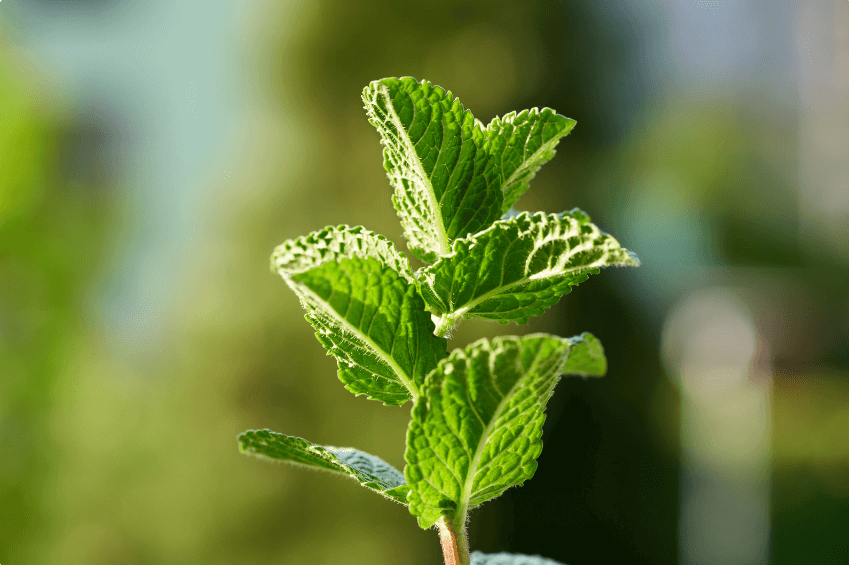
Peppermint
Share

Common Name Brandy Mint,Balm Mint
Family Name Lamiaceae
Parts Used Stem & Leaf
Herbal Actions Carminative, Antispasmodic, Analgesic, Aromatic, Antimicrobial
Health Benefits Digestive Health, Respiratory Relief, Mental Clarity
What are the Benefits of Peppermint?
Peppermint, revered for centuries in various cultures, is a highly esteemed herb in herbal medicine due to its potent therapeutic qualities.* Energetically, this herb is considered a cooling agent that’s refreshing in taste and invigorating in application. It’s a staple in herbal remedies and is widely used to enhance digestive health, soothe headaches, and improve mental clarity.
Rich in menthol, which provides its characteristic cooling sensation, Peppermint is also loaded with antioxidants, including rosmarinic acid and flavonoids. These compounds make it an effective aid in supporting the body's immune system and combating oxidative stress.* Recognized as a "digestive powerhouse," Peppermint is beneficial not only for its ability to relieve digestive issues like bloating and indigestion but also for its antimicrobial properties that contribute to oral health.
Its vibrant flavor and cooling effect make Peppermint a popular choice not only in herbal teas and medicinal preparations but also in culinary uses, where it is infused into beverages, desserts, and sauces. This widespread use underscores its value in enhancing daily health and comfort, making Peppermint a cherished herb in both traditional and modern health practices.
Historical Use of Peppermint
Peppermint, known scientifically as *Mentha piperita*, has been highly valued across various cultures for its vibrant flavor and extensive medicinal properties. Historical records indicate that peppermint has been used since ancient times, particularly within European and Middle Eastern cultures, for both its therapeutic benefits and spiritual significance.
In ancient Greece and Rome, peppermint was commonly used in soirees and as a decorative element in homes and temples to cleanse the air and evoke a sense of freshness and vitality. It was believed to soothe the spirits and bring about peace and restoration. The Romans also used peppermint in their bathing rituals, adding leaves to the water to stimulate and rejuvenate the senses.
During the Middle Ages, peppermint gained spiritual and protective connotations. It was used in various religious ceremonies and rituals to purify the environment and ward off evil spirits, much like the wild cherry was used by the Iroquois. Monks cultivated peppermint in monastery gardens, using it extensively for its health properties and in sacred rites, symbolizing hospitality and wisdom.
In traditional herbal medicine, peppermint was a staple remedy used to aid digestion, relieve headaches, and treat cold symptoms. It was also commonly carried as a charm for protection and to ensure safe travel, demonstrating its deep-rooted significance in folklore and herbal practice.
This historical usage of peppermint reflects its versatile role in enhancing health, enriching spiritual practices, and contributing to cultural traditions, echoing its enduring presence in both medicinal and ceremonial contexts.
Botanical Description & Habitat
Peppermint is a perennial herb that grows to about 30 to 90 cm (12 to 35 inches) tall. It is a hybrid mint, a cross between watermint (Mentha aquatica) and spearmint (Mentha spicata), characterized by its smooth and often purple-colored stems. The plant spreads vigorously via its underground rhizomes.
The leaves of peppermint are dark green with reddish veins, and they can be 4 to 9 cm long and 1.5 to 4 cm broad. The leaves are lanceolate, sharply serrated, and have a distinctive, refreshing menthol scent when bruised.
Peppermint flowers in the late summer and produces small purple flowers in whorls around the stem, forming thick, spike-like inflorescences. The flowers are hermaphroditic, meaning they have both male and female organs, and are pollinated by insects.
Originally a cultivar, peppermint does not have a true wild form but has been widely naturalized across Europe, North America, and other regions. It thrives in moist, shaded locations but can also grow in direct sunlight if sufficient water is provided. The plant prefers stream banks and areas near water bodies where the soil remains damp.
Peppermint generally flourishes in rich, moist soil with a pH between 6.0 and 7.0. While it can tolerate a range of soil types, it performs best in soil that is well-draining but retains moisture. The plant is frost tolerant and typically planted in spring after the last frost.
In garden settings, peppermint can be somewhat invasive due to its vigorous growth and should be contained, often grown in pots or areas where it can be controlled. It is commonly cultivated both commercially and in home gardens for its essential oils, culinary uses, and medicinal properties.
